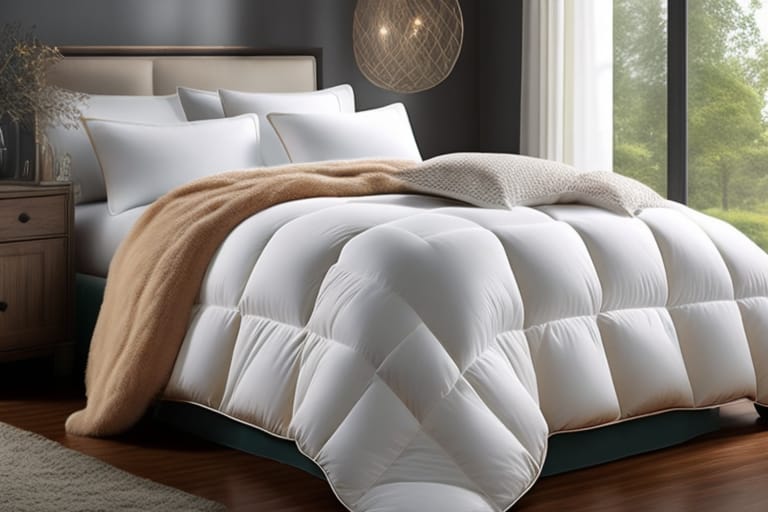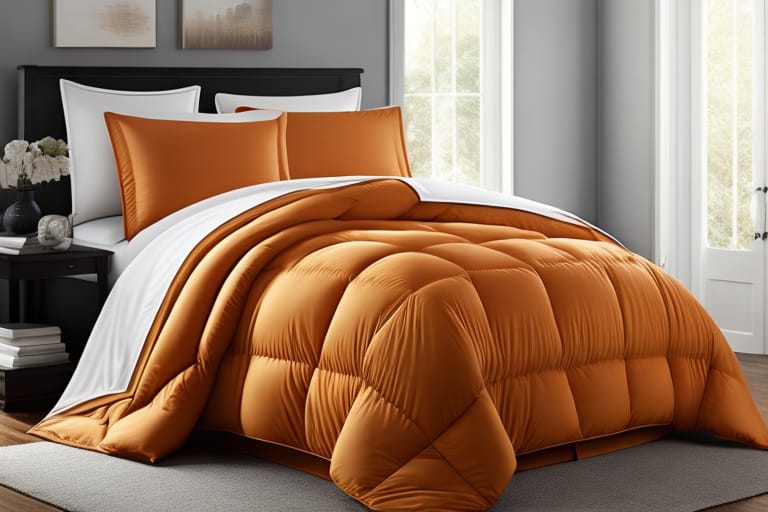When it comes to providing ultimate warmth and comfort for your bed, a down comforter really can’t be beaten. Often hailed as the “rolls royce” of bedding for their unmatched coziness, down comforters are prized for their spectacular softness and lightweight feel. But with so many options on the market, how do you choose the right down comforter for your needs?
This beginner’s guide will walk you through everything you need to know when shopping for a down comforter. We’ll cover factors like fill power, construction, size, and more to help you select your ideal model. By understanding the different qualities of these luxurious bed covers, you’ll be equipped to invest in one you’ll love sleeping under for years.
How to Choose the Best Down Comforter
From determining the right warmth rating to assessing fill power numbers, there’s a lot that goes into finding your perfect down comforter match. Keep these key criteria in mind as you shop:
Fill Power
The fill power of down refers to the loft and insulation ability of the down clusters inside your comforter. It’s measured as a number between 400-900, with higher numbers indicating better quality down with more insulating air pockets.
- 700-900 fill power = exceptional quality, maximum loft and warmth
- 600-699 fill power = excellent quality, ideal for year-round use
- 500-599 fill power = very good quality, great for cooler weather
- Under 500 fill power = decent quality, best for summer or budget buyers
Construction and Design
From baffle boxes to corner ties, the construction plays a huge role in a down comforter’s overall quality. Look for these hallmarks of a well-made comforter:
- Baffle-box design – Prevents the fill from shifting and forming cold spots
- Corner ties – Attach the comforter to your duvet so it stays in place
- Tight, double stitching on the outer edges for enhanced durability
Durability also depends on the shell fabric, with higher thread counts typically lasting longer. Many comforters feature striped damask weaving for visual appeal.
Size
Pay attention to sizing dimensions so your new down comforter properly fits your bed with an attractive overhang. Consider the loft too – thicker comforters need more overhang space.
For a more custom, tailored look, some companies offer made-to-order sizing.
Allergy Considerations
Down allergies are rather uncommon, but it is possible to be allergic to the natural oils in duck or goose down. Seek out hypoallergenic options certified by IDFL, Downmark, or OEKO-TEX if allergies are a concern.

The Best Down Comforters You Can Buy
Brooklinen’s Down Comforter – Best Overall
Brooklinen is renowned for its ultra-soft bedding, and their premium down comforter is no exception. With Canadian Hutterite goose down and a 700 fill power, it provides the perfect year-round warmth and plushness.
The baffle box-stitching keeps the down evenly distributed while the 300 thread count sateen cotton shell offers durability, breathability and a smooth hand-feel. Add in the reasonable price point for a quality down comforter and it’s easy to see why Brooklinen is a top choice for many shoppers.
Pacific Coast’s Feather Micro Comforters – Most Lightweight
Weighing almost next to nothing, these lofty comforters live up to the name “feather light.” Not only does the baffle-box channel design keep the [hyper: goose down] [hyper: feather blend] well distributed, it allows heat to circulate so you stay cozy but never overheated.
Pacific Coast offers an extensive range of sizes, colors & patterns to find your perfect fit. The “paper thin” barrier weave cover adds surprising strength and longevity, making it a solid value. It feels fluffy yet breathable – ideal if you run hot but still want that sink-in luxury feel.
Amerisleep’s Recover+ Duvet Insert – Softest on Skin
Embedded with Celliant minerals, Amerisleep’s Recover+ comforter converts body heat into infrared energy, helping boost circulation and promote rejuvenating rest. The outside pairs a supima cotton sateen weave with an ultra-plush polyester fill for exceptional softness.
Designed to pair with their Recover+ duvet cover, it features convenient corner ties to keep it in place. With outstanding comfort and recovery-focused craftsmanship, Amerisleep is a top choice if skin-soothing luxury tops your list.
What Really Makes a “Quality” Down Comforter?
Identifying a quality down comforter comes down to understanding these key indicators:
- Fill power – Higher numbers mean better insulation and durability
- Construction – Tight, double stitching prevents tears while baffle boxes limit shifting
- Fabric shell – Softer, smoother fabrics with a higher thread count last longer
- Down purity – Ensure the manufacturer meets IDFL standards for down purity
- Durability – Well-constructed comforters maintain their loft and feel over regular use
- Shape retention – High fill power down springs back after compression for consistent comfort
By inspecting the above criteria, you can determine whether a comforter actually delivers on its claims of quality craftsmanship and materials.
Expert Tips for Purchasing a Down Comforter
We asked Eliza Franklin, Director of Education for the American Down and Feather Council, for her top tips on finding your perfect down comforter:
“Start by deciding which season you need the comforter for – lightweight or summer vs. winter and cold weather use. From there, choose a fill power in the right range – I usually recommend 600-650 fill power as optimal for year-round comfort. Don’t forget to measure your bed’s dimensions and mattress height when selecting a size so you get that perfect overhang. Finally, look for reputable certifications like Downmark or IDFL that verify quality standards.”
Caring for Your Investment
Like any quality purchase, proper care is key to enjoying your down comforter for years. Be sure to:
- Only dry clean your comforter once every 2-3 years max, or as needed
- Use a duvet cover to protect the shell fabric against oils and dirt
- Store in a breathable cotton case during warmer months
- Fluff it regularly to maintain maximum loft
With the right care to preserve resilience and warmth, a good down comforter should last over a decade if it’s well-made.

Ready for Luxurious Sleep?
While high quality down comforters often exceed $1000+ for maximum loft and impressive craftsmanship, you can still find excellent options under $500. Focus first on securing the right warmth rating and dimensions before assessing features. An ultra-soft down encasement always upgrades the sleep experience, but you want the foundation to suit your seasonal and sizing needs above all.
Down comforters may require more upfront investment, but their unrivaled longevity, cloud-like feel, and temperature-regulating abilities make them worthwhile for years of cozy, restorative rest.
Frequently Asked Questions
What’s the difference between down and feathers?
Down refers to the soft, fluffy clusters that form underneath waterfowl feathers and provide exceptional insulation. Feathers have a more structured, rigid shape that lend support but less loft. Most premium down comforters focus specifically on fine, quality down fill rather than feathers.
How often should you replace your down comforter?
With proper maintenance and care, a quality down comforter will last over a decade thanks to its durability and resilience. As long as it retains its loft and insulating abilities and hasn’t accumulated damage or tears, you don’t need to replace it very often.
What thread count is best?
For down comforter shell fabric, look for a thread count between 200-500. Higher thread counts above 600 tend to use thinner threads that may sacrifice long-term sturdiness. Lightweight shell fabrics with a tightly woven 200-500 thread count deliver breathability with strength.
How do I know if a comforter will keep me warm enough?
Pay attention to the fill power – that measures the insulation and cold-weather performance. Fill power between 600-650 provides excellent, all-season warmth for most sleepers. If you really feel the cold, look for options 700+ fill power instead. Some brands also specify warmth ratings like “extra-warm” to indicate intended use.
Should I get a bigger comforter than my actual bed size?
Yes – the right overhang improves the overall look and feel. Add around 18-20 inches lengthwise to ensure an attractive overhang when the top and sides drape over your mattress. The more loft in your comforter, the more overhang breathing room you’ll want.








